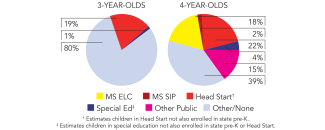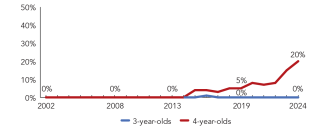
State of Preschool
Mississippi
Access Rankings
Resource Rankings
Total Benchmarks Met
Overview

During the 2023-2024 school year, Mississippi preschool enrolled 7,145 children, an increase of 1,816 from the prior year. State spending totaled $30,542,900, and an additional $1,251,287 in federal recovery funds supported the program, up $14,395,473 (83%), adjusted for inflation, since last year. State spending per child (including federal recovery funds) equaled $4,450 in 2023-2024, up $1,185 from 2022-2023 adjusted for inflation. Mississippi met 10 of 10 quality standards benchmarks.
What's New
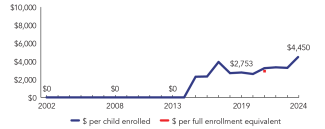
During the 2023-2024 school year, the state appropriated $20,040,000 for SIP. In 2024, the Mississippi Legislature issued an additional $5 million to the Early Learning Collaborative (ELC) program but decreased the funding for the State Invested Pre-K (SIP) program by $5 million, thereby level funding pre-K in the state across the two programs. The funding was shifted because the ELC program reaches more children due to the mixed delivery model, while SIP is based only in public school classrooms. With the additional funding, the ELC program increased the funding per seat from $2,500 to $3,500 during the 2024-25 school year. However, despite the decrease in funding for SIP, program quality standards remained consistent.
Additionally, during the 2024-2025 school year, the state changed the requirements for teacher assistants to assist with recruitment and retention. Going forward, teacher assistants must possess a high school diploma/GED, verification of WorkKeys scores, and 12 hours early childhood college credit hours, or they must have a certificate of completion of an early childhood training program, pre-K Child Development Associate (CDA) credential, a Montessori certification, or an equivalent certification.
Background
The Early Learning Collaborative (ELC) Act of 2013 established Mississippi’s first state-funded, voluntary pre-K program. The ELC Act provides funding to local communities to establish, expand, support, and facilitate the successful implementation of quality early childhood education and development services. Implementation began in January 2014, with the capacity to serve 1,774 children. The program was initially funded at $3 million per year and has expended with additional funding to serve more children. As long as the ELC Act of 2013 is funded, current Collaboratives that meet program requirements will continue to be funded. Pre-K programs in Head Start centers, licensed child-care facilities, and public, parochial, or private schools formed and maintained stakeholder councils called ELCs, involving at least two program auspices.
During the 2022 legislative session, $20 million was appropriated to fund additional preschool programs in school settings, specifically in the new State Invested Pre-K (SIP) Program. SIP classrooms are in public schools; however, these classrooms can include children who are dually enrolled in Head Start. Although this funding was received during the 2022-2023 program year, children were served in classrooms beginning in August 2023.
SIP provides funding per classroom and not funding per student. Each SIP classroom receives $100,000 to create or improve PreK-4 classrooms. In addition, for each SIP program that chooses to dual enroll students with a Head Start program, these programs receive an additional $25,000 per classroom totaling $125,000 per classroom. Thus, the total of funding per child as presented in this report may demonstrate an inflated per child funding amount. Classrooms in SIP programs vary in size; thus, if a classroom meets the standard operating requirements and are a part of SIP, that classroom receives the qualified amount of funding regardless of class enrollment. This is one of the unique features of the SIP program that is different from the Early Learning Collaborative program, which is funded per child.
ELC & SIP intend to improve quality, increase access to high-quality pre-K programs for 4-year-olds, and prepare more children to enter kindergarten ready to succeed in school. These programs also support local programs in their efforts to improve pre-K quality and access. Pre-K programs also implement an integrated, effective system of early childhood curriculum, instruction, assessment, and program evaluation, which includes the utilization of evidence-based curricula aligned with the Mississippi Department of Education’s Early Learning Standards for Classrooms Serving Infants through Four-Year-Old Children.
-
Access
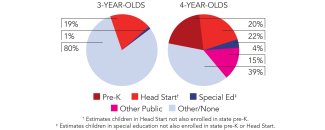
Total state pre-K enrollment 7,145 Special education enrollment, ages 3 and 4 3,753 Federally funded Head Start enrollment, ages 3 and 4 14,799 State-funded Head Start enrollment, ages 3 and 4 0 Resources
Total state pre-K spending $31,794,188 State Head Start spending $0 State spending per child enrolled $4,450 All reported spending per child enrolled* $9,753 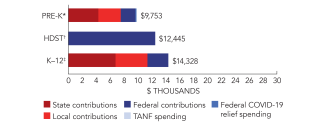
*Pre-K programs may receive additional funds from federal or local sources that are not included in this figure. †Head Start per-child spending includes funding only for 3- and 4-year-olds. ‡K–12 expenditures include capital spending as well as current operating expenditures.
-
Access
Resources
Total state pre-K spending $22,229,188 Local match required? Yes State spending per child enrolled $3,358 All reported spending per child enrolled* $9,556 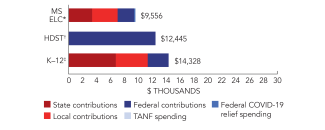
*Pre-K programs may receive additional funds from federal or local sources that are not included in this figure. †Head Start per-child spending includes funding only for 3- and 4-year-olds. ‡K–12 expenditures include capital spending as well as current operating expenditures.
Mississippi Early Learning Collaborative Quality Standards Checklist
| Policy | MS ELC Requirement | Benchmark | Meets Benchmark? |
|---|---|---|---|
For more information about the benchmarks, see the Executive Summary and the Roadmap to State pages. | 10benchmarks met | ||
| Early Learning & Development Standards Benchmark | Comprehensive, aligned, supported, culturally sensitive | Comprehensive, aligned, supported, culturally sensitive | |
| Curriculum Supports Benchmark | Approval process & supports | Approval process & supports | |
| Teacher Degree Benchmark | BA | BA | |
| Teacher Specialized Training Benchmark | ECE, CD | Specializing in pre-K | |
| Assistant Teacher Degree Benchmark | AA in ECE | CDA or equivalent | |
| Staff Professional Development Benchmark | 15 hours/year; PD plans; Coaching | For teachers & assistants: At least 15 hours/year; individual PD plans; coaching | |
| Maximum Class Size Benchmark | 20 (4-year-olds) | 20 or lower | |
| Staff to Child Ratio Benchmark | 1:10 (4-year-olds) | 1:10 or better | |
| Screening & Referral Benchmark | Vision, hearing, health & more | Vision, hearing & health screenings; & referral | |
| Continuous Quality Improvement System Benchmark | Structured classroom observations; Data used for program improvement | Structured classroom observations; data used for program improvement | |
-
Access
Resources
Total state pre-K spending $9,525,000 Local match required? No State spending per child enrolled $11,096 All reported spending per child enrolled* $11,190 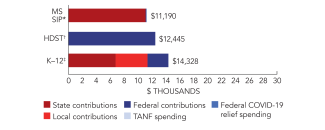
*Pre-K programs may receive additional funds from federal or local sources that are not included in this figure. †Head Start per-child spending includes funding only for 3- and 4-year-olds. ‡K–12 expenditures include capital spending as well as current operating expenditures.
Mississippi State Invested Pre-Kindergarten Quality Standards Checklist
| Policy | MS SIP Requirement | Benchmark | Meets Benchmark? |
|---|---|---|---|
For more information about the benchmarks, see the Executive Summary and the Roadmap to State pages. | 10benchmarks met | ||
| Early Learning & Development Standards Benchmark | Comprehensive, aligned, supported, culturally sensitive | Comprehensive, aligned, supported, culturally sensitive | |
| Curriculum Supports Benchmark | Approval process & supports | Approval process & supports | |
| Teacher Degree Benchmark | BA | BA | |
| Teacher Specialized Training Benchmark | ECE, CD | Specializing in pre-K | |
| Assistant Teacher Degree Benchmark | CDA | CDA or equivalent | |
| Staff Professional Development Benchmark | 15 hours/year; PD plans; Coaching | For teachers & assistants: At least 15 hours/year; individual PD plans; coaching | |
| Maximum Class Size Benchmark | 20 (4-year-olds) | 20 or lower | |
| Staff to Child Ratio Benchmark | 1:10 (4-year-olds) | 1:10 or better | |
| Screening & Referral Benchmark | Vision, hearing, health & more | Vision, hearing & health screenings; & referral | |
| Continuous Quality Improvement System Benchmark | Structured classroom observations; Data used for program improvement | Structured classroom observations; data used for program improvement | |
